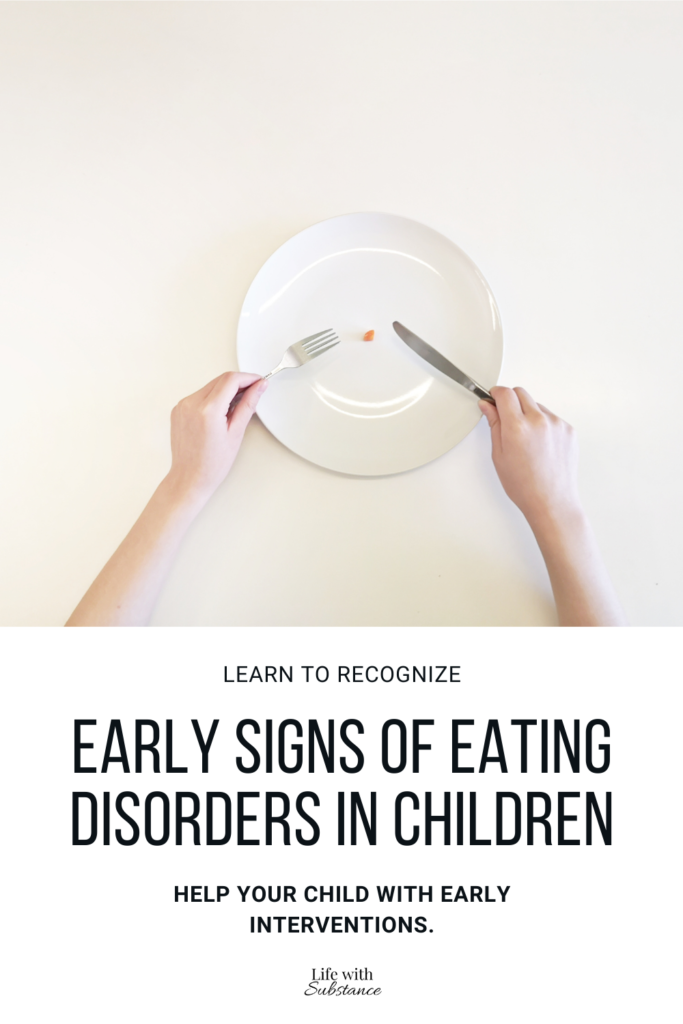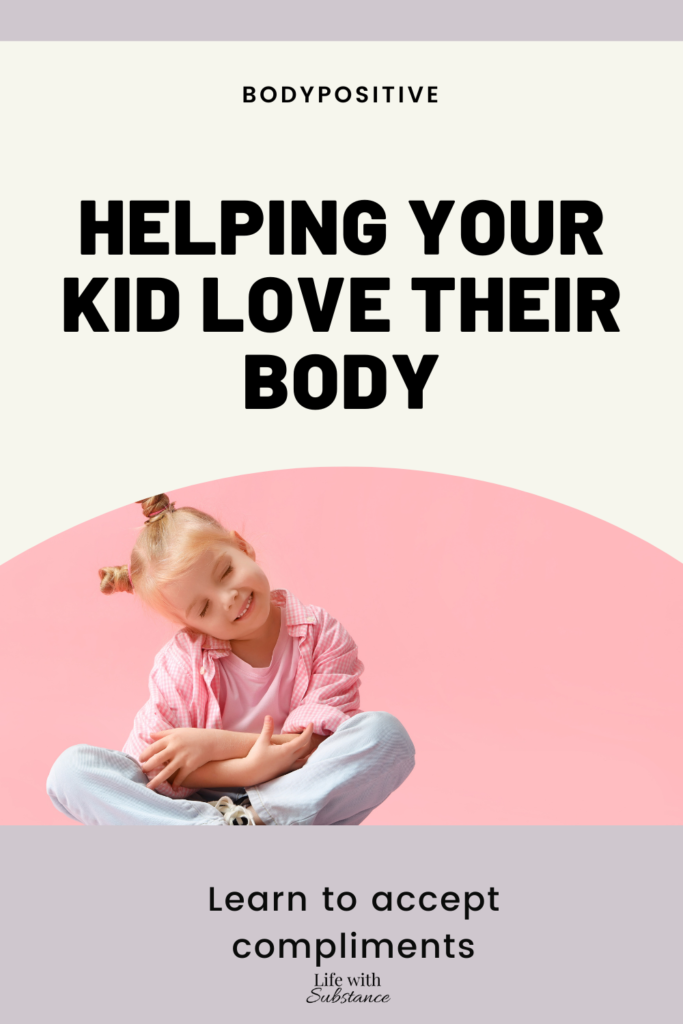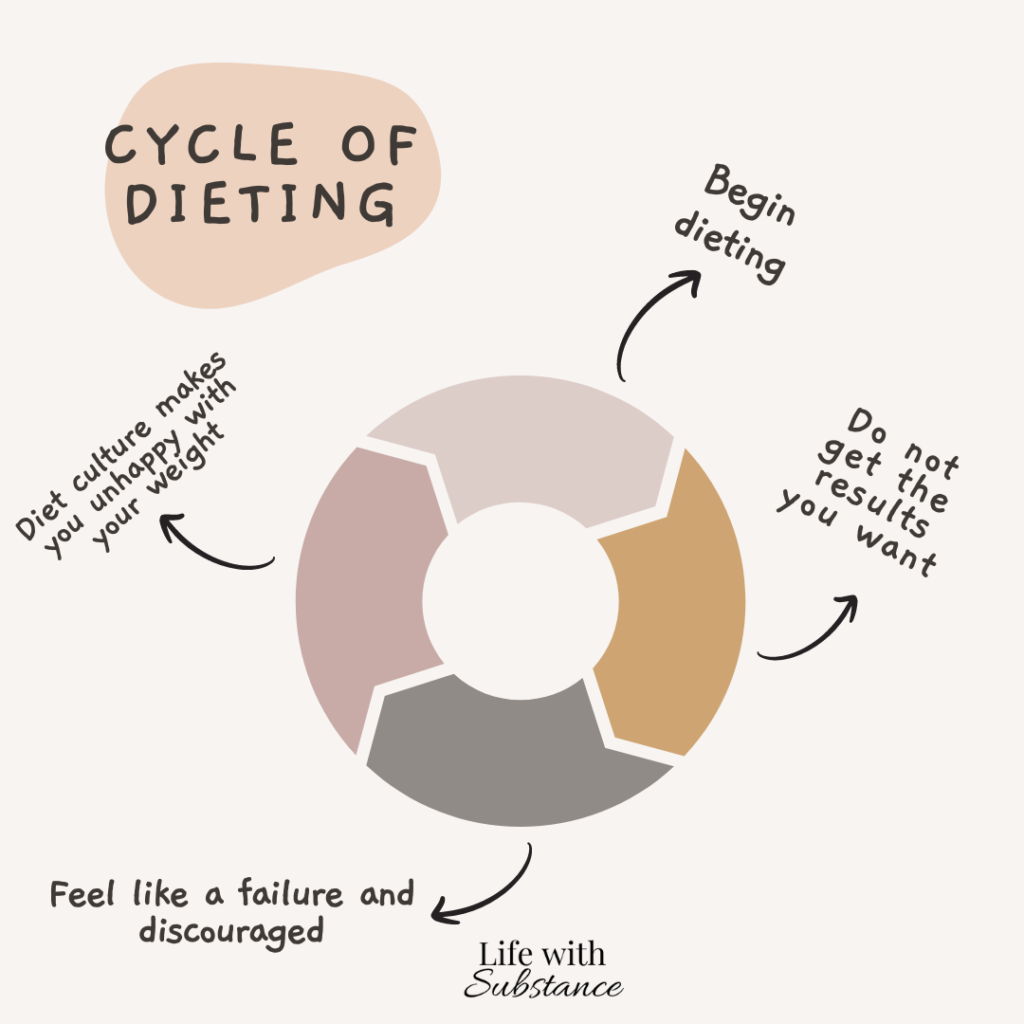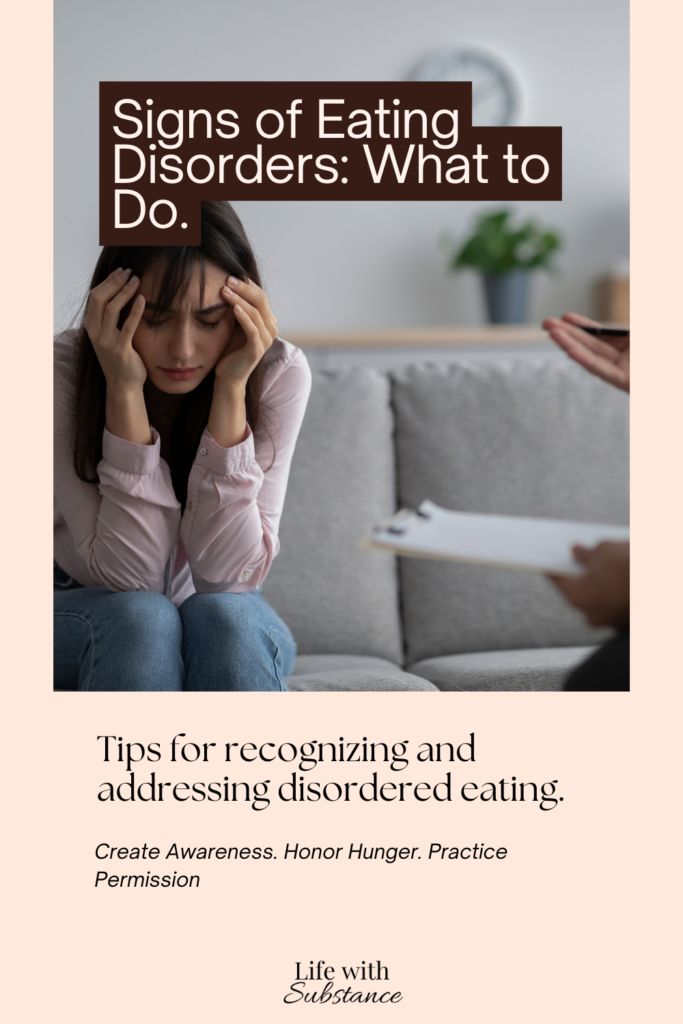This post may contain affiliate links. If you shop from one of our links, we may earn a commission.
In today’s image-focused society, it’s increasingly common for children and teenagers to feel pressure about their appearance, which can sometimes lead to an eating disorder. As parents, it’s crucial to recognize the early signs of such issues to provide the necessary support and intervention. This post aims to help you identify and understand the nuances of disordered eating behaviors in children, offering insights into what to look out for and how to approach the situation compassionately and effectively.
- Disordered Eating Versus Eating Disorder Versus “Normal Eating”
- Statistics
- Recognizing Body Dissatisfaction in Kids
- 5 Warning Signs of an Unhealthy Relationship with Food and Body
- Signs of an Eating Disorder versus Disordered Eating
- What You Can Do When Signs of Disordered Eating or Eating Disorders Appear
- In Summary
Disordered Eating Versus Eating Disorder Versus “Normal Eating”
Disordered eating and eating disorders, although often used interchangeably, represent different positions on the spectrum of eating behaviors. An eating disorder, such as anorexia nervosa or bulimia, is diagnosed based on specific criteria and involves severe disruptions in eating behaviors, often coupled with intense concerns about body weight and shape.
Disordered eating, on the other hand, encompasses a range of irregular eating behaviors that may not qualify for an eating disorder diagnosis. These behaviors can include following strict dietary rules, categorizing food as strictly “good” or “bad,” and engaging in periodic dieting.
Between these two lies “normal eating,” which involves eating when hungry, stopping when full, and not being overly concerned with food or body image. It’s marked by flexibility and the ability to rely on internal cues rather than external rules. The journey from disordered eating towards “normal eating” is often navigated through nutrition counseling, focusing on unlearning external rules and reconnecting with the body’s internal signals. Understanding the distinction between these concepts can help in recognizing the varying degrees of eating behavior and the necessity for different approaches in addressing them.

Statistics
Statistics from the National Association of Anorexia Nervosa and Associated Disorders show:
- 42% of 1st-3rd grade girls desire to be thinner
- 81% of 10-year-old children are worried about becoming fat
- 46% of 9-11 year-olds are “sometimes” or “very often” on diets
- 35-57% of adolescent girls participate in crash dieting, fasting, self-induced vomiting, diet pills, or laxatives
- In a college campus survey, 91% of the women admitted to controlling their weight through dieting
We are constantly bombarded with messages from diet culture voicing foods as “good” or “bad” and setting standards for the image of health. But how our kids (and ourselves) choose to internalize these messages determines their relationship with food and their body. Not to mention, we need to eat multiple times per day, making it easy to obsess over food.
Unfortunately, due to the increasing amount of eating disorders and disordered eating in kids and teens, as parents we need to be diligent to ensure they have a healthy relationship with food and their body.
Recognizing Body Dissatisfaction in Kids
Children might start voicing concerns about their appearance at a young age, even before their teen years, influenced by a range of external factors like social media, peers, and conversations they overhear. This dissatisfaction often manifests through negative self-talk or comparisons to others, marked by a persistent desire to alter their physique. Such early signs are crucial indicators of potential disordered eating behaviors.
Monitoring how your child talks about their body and others’—especially if they express an urge to engage in excessive exercise routines or dieting—can provide early warning signs. It’s important to listen attentively to these expressions, as they reflect a growing preoccupation with body image that could escalate into more harmful behaviors. Engaging in open, non-judgmental discussions about body image and self-esteem can help address these issues before they evolve into more serious concerns.
5 Warning Signs of an Unhealthy Relationship with Food and Body
Everyone internalizes their relationship with food and body slightly different. However, many kids struggling with an unhealthy relationship with food or body share these common symptoms mentioned below.

The Emergence of Strict Food Rules or Dieting
When children begin to impose rigid guidelines around eating, it signals a shift towards disordered habits. This might manifest as an abrupt elimination of certain foods deemed ‘unhealthy’ or an obsessive tracking of calories and nutritional content. Distinguishing between an interest in healthy eating and behavior that limits essential nutrients is critical. You might notice sudden dietary changes, like a complete avoidance of fats or an unexpected commitment to veganism, without a genuine understanding of its principles.
These behaviors often stem from a deeper issue related to poor body image and can escalate if not addressed. Conversations about these changes should aim to uncover the underlying reasons, focusing on their feelings and perceptions about food and their body. Observing these signs and understanding their implications can prompt discussions that navigate away from guilt and restriction towards a healthier relationship with food.
Changes in Body Shape or Size and Reaction to Compliments
During the developmental years, it’s natural for children to experience fluctuations in their weight and body composition. However, in those showing signs of disordered eating, these changes might be more noticeable and accompanied by a shift in behavior, particularly in how they react to observations about their appearance. Compliments on weight loss or body transformation, meant to be encouraging, can inadvertently perpetuate harmful practices. If a child’s response to praise focuses intensely on their appearance, it could indicate that their self-worth is becoming heavily tied to their physical attributes.
This fixation can drive them to adopt further unhealthy habits in pursuit of additional approval. Observing your child’s reactions to such comments offers a window into their mindset regarding body image and the potential influence of disordered eating patterns. It’s essential to monitor these interactions, as they can reveal underlying issues with body satisfaction and the potential risk of escalating disordered eating behaviors.

Escalation to More Extreme Behaviors
As disordered eating behaviors intensify, they can manifest in increasingly severe forms with symptoms of anorexia or binge eating disorder. Children may start engaging in excessive physical activity, pushing their bodies far beyond healthy limits, or they might begin avoiding meals, substituting solid foods with liquids, or adhering to strict and inflexible eating schedules.
Observing changes such as these—particularly when accompanied by signs of distress or frustration when routines are disrupted—signals a deepening of the unhealthy relationship with food and exercise. Such extremes not only jeopardize their physical well-being but also reinforce the cycle of disordered eating by embedding these habits more firmly into their daily lives. Recognizing these actions as more than just a phase or a heightened interest in fitness is crucial; they are red flags indicating that the child’s perspective on health and self-care is veering dangerously off course.
Fear of Losing Control
The intense dread of relinquishing command over dietary habits, physical activity, and body weight is a hallmark of disordered eating. This overwhelming apprehension can dominate a young person’s thoughts, ushering in profound anxiety at the mere prospect of diverging from their stringent routines. When faced with the possibility of deviation, these individuals may exhibit signs of withdrawal or adopt a defensive stance regarding their lifestyle choices.
Navigating these delicate discussions requires a tactful and understanding approach, aiming to provide a safe environment where they can express their concerns and fears without feeling judged. Engaging with empathy and support is vital in encouraging an open dialogue, helping to illuminate the underlying issues driving their fear, and facilitating a path toward healing.
The Dangerous Cycle of Repetition
The pattern of disordered eating often evolves into a perilous loop, characterized by strict rule adherence, followed by lapses that prompt intense feelings of guilt and shame. This sequence leads individuals to impose even harsher restrictions on themselves in an attempt to ‘correct’ these deviations. This self-perpetuating cycle exacerbates the emotional and physical strain on the individual, trapping them in a relentless pursuit of unattainable perfection. It’s this cyclical nature that makes eating disorders particularly challenging to overcome, reinforcing harmful behaviors and mindsets.
Identifying this cycle is a crucial step toward intervention, highlighting the need for compassionate support and professional guidance to navigate the complexities of recovery and break free from the confines of disordered eating patterns.

Signs of an Eating Disorder versus Disordered Eating
We have discussed the difference between disordered eating and eating disorders earlier. There are key warning signs to watch for when disordered eating has transformed into an eating disorder. Early detection of an anorexia or binge-eating disorder can significantly enhance the efficacy of treatment and support.
Look out for tell-tale signs such as significant weight loss, especially when not related to a health condition and a distorted body image where the individual may perceive themselves as overweight despite being underweight. Teenage girls might experience missed periods or a complete cessation of the menstrual cycle, indicating a potential health issue linked to restrictive eating habits.
Other common warning signs include wearing baggy clothes in an attempt to hide body shape or weight changes, hair loss, and preoccupation with food, calories, and dieting are also red flags that should not be ignored. Other medical complications can include lab abnormalities and a low heart rate. Conditions such as bulimia nervosa might manifest through episodes of binge eating followed by purging.
Early detection is crucial in addressing these concerns effectively. If you notice symptoms of an eating disorder, consider scheduling a physical exam with your child’s pediatrician to discuss treatment options who may then refer you to a dietitian and therapist specializing in eating disorders. A comprehensive approach, potentially involving a treatment center, can provide the necessary care and guidance for recovery.
What You Can Do When Signs of Disordered Eating or Eating Disorders Appear
Early intervention is always best to prevent more severe complications of an eating disorder. When recognizing some of the above eating disorder symptoms, you can start here with these 3 interventions.

Create Awareness
Once you’ve identified the worrying signs of eating disorder behaviors, initiating a conversation with your child is a critical next step. Approach this dialogue with an open heart and mind, aiming to explore their feelings and behaviors without casting blame or making assumptions.
Begin by expressing your observations and concerns about their eating patterns or body insecurity in a supportive manner. It’s essential to foster an environment where your child feels safe to express their thoughts and emotions. Inquire gently about where their perceptions of food and body image might have originated. Perhaps they’ve been influenced by social media, peers, or misconceptions presented in social situations.
Have your child identify food rules or restrictions that they may have recently adopted and discover where those thoughts came from. For example, if your child has been avoiding foods with added sugar, ask questions such as:
- Where did that food rule come from?
- How do you feel when you avoid added sugars?
- What would happen if you choose to gradually add some of those foods back in?
Encourage them to share their feelings, fears, and motivations behind their eating habits, highlighting your intention to understand rather than judge. This approach opens a pathway for honest communication, helping them to see that their worth extends far beyond physical appearance or dietary control.
By addressing these topics with curiosity and care, you lay the groundwork for a healthier perspective on food and positive body image, steering them away from the pitfalls of body insecurity and disordered behaviors.
Honor Hunger
Honoring hunger is a crucial step toward dismantling disordered eating behaviors and rebuilding a healthy relationship with food. When individuals ignore or suppress their hunger signals, it can initiate a harmful cycle of restricting calorie intake, which paradoxically intensifies cravings and often leads to periods of binging. This cycle can manifest as a sign of an eating disorder. By recognizing and responding to hunger and fullness cues, individuals can start to trust their body’s signals again, breaking free from the cycle of binging and restricting.
It’s vital to understand that honoring hunger does not mean giving in to every craving without mindfulness; rather, it involves acknowledging when the body needs nourishment and providing it with adequate, nutritious food.
This approach can help prevent the following warning signs of disordered eating, such as an unhealthy preoccupation with calorie intake and food restriction. Learning to respect the body’s hunger signals is a key step in nurturing a positive and intuitive eating habit, fostering a sense of balance and well-being in one’s relationship with food.
Practice Permission
In the journey toward healing disordered eating, dismantling the framework of food rules—identifying certain items as inherently “good” or “bad”—is essential. This dichotomy contributes to unhealthy relationships with food, where body size and self-worth become intertwined with what one has or has not eaten.
Intuitive eating, a compassionate self-care eating framework, encourages us to reject the diet mentality that glorifies certain food groups while demonizing others. It teaches us to honor our hunger, respect our fullness, and find joy in eating. Two fundamental principles of intuitive eating, rejecting the diet mentality and discovering the satisfaction factor, empower individuals to give themselves unconditional permission to enjoy food.
This approach is a good idea for anyone looking to heal their relationship with food and body. By adopting these rules, we learn that all foods can fit into a balanced diet, removing the power of food to dictate our feelings of worth. This permission to enjoy food, free from guilt and without conditions, fosters a nurturing environment where eating becomes an act of self-care rather than a source of stress. Engaging with food in this way allows for a healthier body image and a more peaceful relationship with food and one’s body.
I would also like to note that while these are valuable tools to practice as a parent, sometimes these are issues too large to tackle alone. It may be in their best interest to seek further nutritional counseling from a dietitian who is an eating disorder specialist as well as their primary care provider and a therapist.
In Summary
Navigating the path through disordered eating requires vigilance and understanding, particularly in recognizing the early warning signs such as body dissatisfaction, strict food rules, and changes in physical appearance that may be greeted with undue emphasis on compliments. The escalation of these behaviors into more extreme dietary and exercise routines, coupled with a fear of losing control, underscores the pressing need for intervention.
As parents, acknowledging these red flags is the first step toward guiding your child away from the dangerous cycle of disordered eating and possibly an eating disorder. The subsequent steps involve fostering an environment of open communication, where feelings and fears can be shared without judgment, and seeking professional help to address these complex issues.
Encouraging a healthy relationship with food and body image is a journey that may require external support, but it begins within the nurturing confines of the home. By remaining attentive and proactive, parents can play a pivotal role in helping their children navigate these challenges, steering them toward a future where their self-worth is not defined by their physical appearance but by the richness of their character and the breadth of their abilities.
Check out this post for more info on why kids should not be on a diet.

